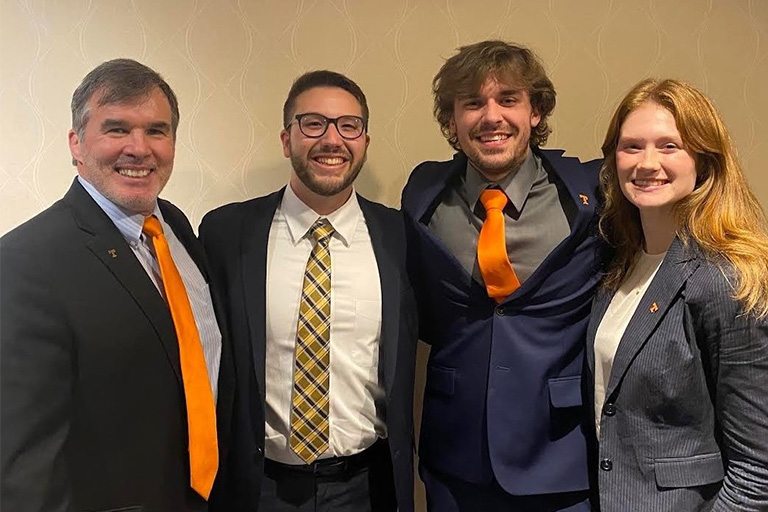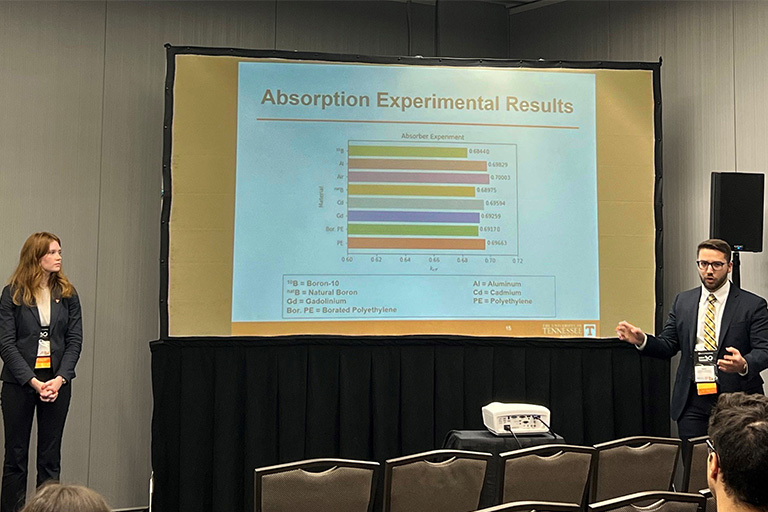When Los Alamos National Laboratory (LANL) needed experts to design equipment that would provide key plutonium safety data, its leaders sought out the best of the best.
They sought out five UT undergraduates.
“I’ve always had a passion to make an impact on the world,” said Daniel Racz (’23), now a PhD candidate under Assistant Professor Ivis Chaple Gore, “and nuclear engineering (NE) gave me the chance to work toward that goal.”
Racz and four of his classmates—Nicholas Branam, Sophia Hitson, Gabe Lentchner, and Sinan Zhang—started tackling LANL’s commission as their Senior Design Project in the fall of 2022.
In November of 2023, their design made them national champions.

Wes Hines (left), Gabe Lentchner, Daniel Racz, and Sophie Hitson at the ANS Winter Meeting in Washington, DC, on November 13, 2023.
A Vol Leading Vols
Tickle College of Engineering students who participate in the Senior Design Program are given creative control over real-world problems.
“The sponsored projects integrate the knowledge our students have gained into something that has practical value,” said Wes Hines, the head of UT’s NE department. “That experience can have an enormous impact on a student’s career.”
Patrick Huston (BS ’19, MS ‘20), the LANL criticality safety engineer and UT alum who mentored Racz and his teammates, is living proof.
“My senior design project required me to use the Monte Carlo N-Particle transport code, which I now use extensively at LANL,” Huston said.
Huston helps LANL maintain subcritical operation parameters, ensuring the safety of the researchers who handle fissionable nuclear materials like plutonium. As of 2023, LANL is the only US facility capable of producing plutonium pits (shells), which are vital to the function of nuclear weapons. Unfortunately, subcritical benchmark data is lacking for plutonium nitrate, the main solution used in producing the pits.
“Without high fidelity benchmark data, we wouldn’t be able to trust our codes,” Huston explained.
LANL challenged Racz and his teammates to design a plutonium nitrate subcritical test assembly (STA), a piece of equipment that can sustain a fission chain reaction only when supplied with neutrons from an outside source, that was flexible enough to investigate multiple factors contributing to reactivity.

Sophie Hitson, and Gabe Lentchner present their design at the ANS Winter Meeting in Washington, DC, on November 13, 2023.
Huston was available for help with the more technical questions, virtually joining team meetings multiple times each week, but let the students steer the project.
“I was very impressed with their professionalism and technical abilities,” Huston said. “We are actually looking at ways we can improve some of our code based on the tool they designed.”
The undergraduates proposed an STA with three cylindrical containers of plutonium nitrate. When apart, none of the containers can sustain fission reactions. However, when placed together, the containers share neutrons, significantly increasing the rate of the reactions but never reaching criticality. Slots in the assembly will also allow LANL scientists to test the efficacy of different shielding materials.
Thanks to their dedication and hard work, the team was awarded Overall Best Senior Design Project and Best Computational Project in the 2023 Department of Nuclear Engineering Senior Design Competition.
Vols Leading the Nation
After the team’s campus win, Hines asked the students to consider applying to the American Nuclear Society (ANS) Student Design Competition. Each year since 1975, the ANS has invited just two undergraduate and two graduate-level teams from across the US to present their research at the ANS Winter Conference.
“It’s a competition against all the other top nuclear engineering students in the country,” Hines said. “We’ve often had finalists present at ANS meetings, but we haven’t won for a while.”
When Hines made the request, Racz, Branam, Hitson, and Lentchner had already been accepted to graduate programs at UT.
“The four of us thought it would be fitting to take part in this excellent opportunity together,” Racz said. “Our group took a lot of pride in representing not only our department, but our university.”
On the second day of the 2023 ANS Winter Conference, judges from industry and government backgrounds convened to watch the Student Design Competition presentations. Racz and his teammates distinguished themselves with comprehensive problem analysis, exhaustive computations in support and evaluation of their STA, and excellent responses to the judges’ questions, clinching the win.

(From left to right) Daniel Racz, Sophie Hitson, Nicholas Branam, and Gabe Lentchner at TCE Senior Design Showcase 2023.
“I am very proud of them,” Huston said. “They did a tremendous job and made an impressive final design.”
Racz felt that being named one of the nation’s top nuclear engineering students was only one of several rewards he earned from the project.
“Winning the ANS Student Design Competition was certainly memorable,” he said, “but the opportunity to learn new skills as a senior, to work alongside my friends, and to build connections outside of UT is what made me feel victorious.”
Contact
Izzie Gall (865-974-7203, egall4@utk.edu)